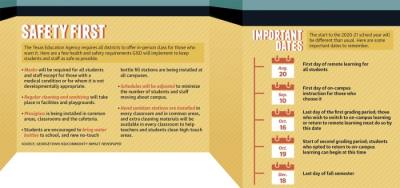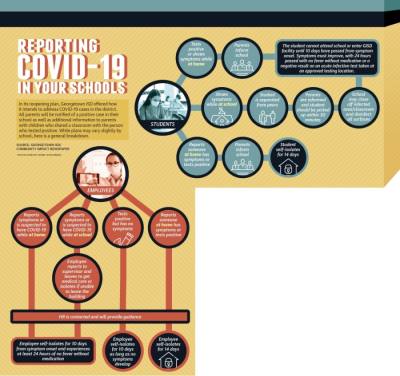GISD announced July 20 that it would begin the school year with remote learning for the first three weeks after two surveys were conducted.
“We feel like it is our responsibility as the foundation of this community to offer in-person learning and support those who do not want in-person learning, and to make sure we take care of the academic needs of both groups,” GISD Superintendent Fred Brent said.
In the second survey in which the district asked if stakeholders wanted to start in-person school immediately or begin with virtual learning, of the 11,632 family responses, 54% said they preferred the school year to start with remote learning as a requirement for all students. Of the 1,943 staff responses, 68% agreed.
The school year will still begin Aug. 20, and optional in-person classes will begin Sept. 10.
Parents had until Aug. 6 to submit learning preferences for their student for either all-virtual or all in-person beginning Sept. 10. Those who did not make a selection are assumed to return to campus, officials said.
Of the total 7,207 students the district is preparing to return to on-campus learning, 5,166 said they would return. The remaining 2,041 did not respond and therefore are assumed.
Parents will also be able to select a different learning preference in the second nine weeks of school—beginning Oct. 19—by making the change on the Skyward Family Access platform on the district’s website. Officials asked that parents make changes at the end of the grading periods due to scheduling and accommodation complexities.
Brent added that as of Aug. 4, the district had no intention of postponing the start of classes or in-person classes.
“We feel like the most prolific learning opportunities occur with student-teacher interaction live and in person,” he said. “We have a lot of families who work and are unable to work if there isn’t a place for their kids to go, and we feel school is the best place for them. We just feel like [schools are] a foundational function of our community and that kids are able to come to school and be cared for.”
Nonetheless, GISD parent Shirley Franklin said she will not be sending her eighth-grade daughter back to school in September and has no plans to send her until a vaccine is available.
Franklin, who said her daughter is high-risk, said even with the district’s frequent communications, not enough guidance has been provided, and she would much rather homeschool her child.
“I won’t allow my child to be used as a guinea pig,” Franklin said in an email. “When there is a vaccine and I know she is protected, is when I will let her go back. For now, she will be homeschooled.”
Transitioning to in-person
In a July 23 release, the Centers for Disease Control and Prevention stated that children appear to be at lower risk for contracting COVID-19 compared to adults, and transmission among children in schools will likely be low.
“Based on current data, the rate of infection among younger school children, and from students to teachers, has been low, especially if proper precautions are followed,” the Center said. “No studies are conclusive, but the available evidence provides reason to believe that in-person schooling is in the best interest of students, particularly in the context of appropriate mitigation measures similar to those implemented at essential workplaces.”
But much of the fears surrounding back-to-school considerations are not directed at the children, but on the adults who will be teaching the kids and might be more susceptible to the virus and its severe impacts.
In an effort to make both students and staff feel safe to return to campus, the district has instilled several safety protocols, including the mandatory wearing of masks for all kindergarten through 12th-grade students and all staff unless exempted for a medical or developmental reason, officials said.
Hand sanitizing stations have been installed in every classroom, and no-touch water dispensers have been installed on every campus.
Through providing these plans and informing teachers and staff of safety protocols that will take place, GISD Assistant Superintendent of Human Resources Lisa Napper said in an Aug. 3 workshop that some teachers have even changed their minds and decided they would like to go back to campus.
“I’ve had a couple teachers who said, ‘Take me off the list; I think I can go back to campus if these [safety protocols] are provided to me,’” Napper said. “I think some of it is just talking through individual teachers [on] what we can do for them, what we can accommodate for them and also letting them know that leave is always an option, too, if this is not working for you.”
Other districtwide safety measures include the installation of plexiglass barriers in cafeterias and libraries, cleaning products in each classroom and social distancing measures taken whenever possible. Measures for specific campuses can be found on each school’s website as campus layouts and needs for students vary.
The district will not, however, offer screening processes. Instead, parents and staff are expected to self-screen for fever or any COVID-19-related symptoms before heading to school.
Quality learning prioritized
One of the greatest concerns shared by parents regards the quality of education their students will receive. In the spring, as schools were closed from one day to the next, the district and its educators scrambled to move to remote learning. This left original lesson plans abandoned as assignments were reduced with flexible deadlines or none at all.
GISD officials have repeatedly stated that this school year, while different, will continue to offer a high-quality education similar to what would have taken place if there was no pandemic. They also said virtual and in-person classes will be of the same caliber.
Terri Conrad, GISD chief strategist for learning and design, told the school board in a July meeting that the district will provide “the content and the relevance and the rigor we need to for our students.”
“It has to be good; it has to be a viable option,” Conrad said of distance learning. “The fact of the matter is we are going to have students [for whom] this is their best option all year, so it cannot be a lesser-than experience than what they are getting in a face-to-face experience.”
District officials said several key differences between the spring of 2020 and the fall will be added time for educators to solidify comprehensive lesson plans; added coordination and support among staff and administration; and the promise of provided technology and hot spot connectors for students prior to the start of the school year.
GISD has been working to become a one-to-one technology district in which it can offer each of its students age-appropriate technology they need for their education. With this pandemic, GISD will be able to achieve that, Chief of Technology and Innovation Lannon Heflin said.
Students will also be required to complete certain assignments daily as part of attendance and will have regular check-ins with teachers, Conrad said. She added that students and parents will also be provided weekly progress reports, another difference from the spring semester.
Attendance will be factored in to daily engagement, and learning will be designed so that it will have student-teacher interactions with work that is turned in and shows progress.
Brent told the board in an Aug. 3 workshop that the challenges in opening the school year during a pandemic must be addressed before and after the start of school.
“It is just part of the world that we are in right now, [as is] accepting the fact we may not know everything yet, but we are going to do everything we can to figure it out because we have people to take care of,” he said.







